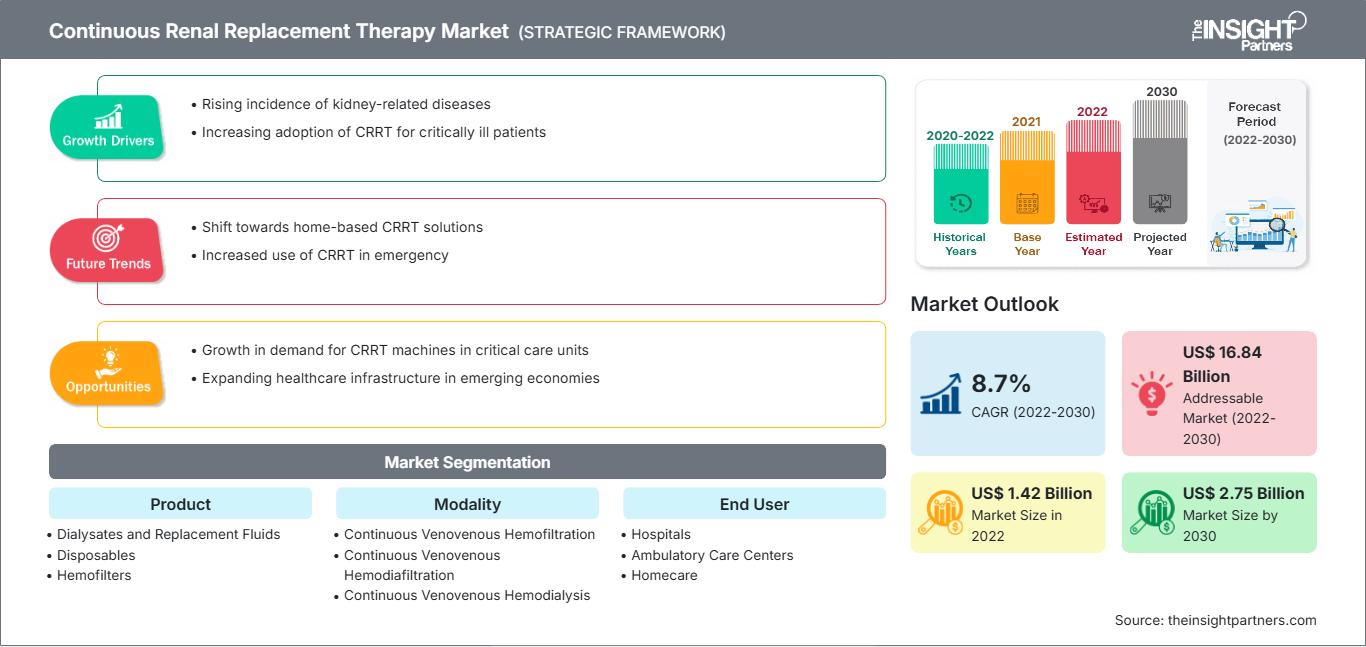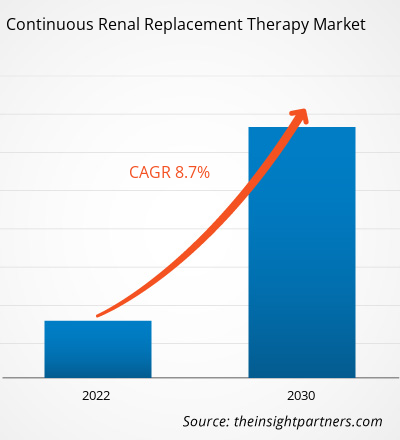[Informe de investigación] Se prevé que el tamaño del mercado de la terapia de reemplazo renal continua crezca de 1.420 millones de dólares en 2022 a 2.750 millones de dólares en 2030. Se estima que el mercado registrará una tasa de crecimiento anual compuesta (TCAC) del 8,7% entre 2022 y 2030.
Perspectivas del mercado y opinión de los analistas:
Este informe incluye las perspectivas de crecimiento derivadas de las tendencias actuales del mercado de la terapia de reemplazo renal continua y su impacto previsible durante el período de pronóstico.
La terapia de reemplazo renal continua (TRRC) es una intervención que salva vidas en pacientes con lesión renal aguda (LRA) grave, sobrecarga de líquidos y uremia, con alteraciones metabólicas potencialmente mortales. Factores como la creciente demanda de dispositivos de TRRC pediátricos y la alta prevalencia de enfermedades crónicas que derivan en nefropatías impulsan el crecimiento del mercado de la terapia de reemplazo renal continua. Sin embargo, la alta probabilidad de un evento adverso renal mayor (EARM) limita dicho crecimiento.
Factores que impulsan el mercado:
Alta incidencia de enfermedades crónicas que conducen a enfermedades renales
Una de cada diez personas en el mundo padece enfermedad renal crónica (ERC), una afección común y potencialmente mortal. Entre 2015 y 2019, la diabetes y la hipertensión arterial fueron las dos principales causas de insuficiencia renal, representando el 75 % del total de casos. Según estimaciones publicadas por la Fundación Nacional del Riñón en 2020, en Estados Unidos, aproximadamente el 30 % de la población diabética mayor de 20 años corre el riesgo de desarrollar ERC a lo largo de su vida. Además, esta enfermedad causó más muertes que el cáncer de próstata o el cáncer de mama en 2020, y se trata de una emergencia médica subdiagnosticada. Uno de cada tres adultos estadounidenses (es decir, aproximadamente 80 millones de personas) corre el riesgo de padecer ERC, la cual se identifica actualmente como un factor de riesgo claro para la lesión renal aguda (LRA). La disminución de la tasa de filtración glomerular (TFG) y el aumento de la proteinuria están fuertemente asociados con la LRA.
Según el Instituto Nacional de Salud, la incidencia de la lesión renal aguda (LRA) está aumentando en los países desarrollados. Se prevé que su prevalencia en pacientes hospitalizados alcance el 15%, y es aún mayor en pacientes críticos, llegando al 60%. La incidencia de LRA en pacientes hospitalizados a nivel mundial oscila entre el 0,7% y el 31%; en las unidades de cuidados intensivos (UCI), la incidencia supera el 50%. Entre el 3% y el 13% de los pacientes con LRA requieren terapia de reemplazo renal (TRR), y se estima que el 40% de estos pacientes necesitarán terapia de reemplazo renal continua (TRRC) durante más de 90 días. Por lo tanto, la alta prevalencia de enfermedades crónicas que provocan nefropatías impulsa el crecimiento del mercado de la terapia de reemplazo renal continua.
Los principales efectos adversos asociados a la terapia de reemplazo renal continua (TRRC) incluyen hipotensión, taquicardia y otras arritmias, que pueden afectar negativamente la condición del paciente o dificultar su recuperación. Además, el circuito de TRRC podría facilitar la eliminación acelerada de micronutrientes, oligoelementos y/o medicamentos, lo que puede ocasionar concentraciones bajas o irregulares en sangre y tejidos, causando así efectos adversos y/o pérdida del efecto terapéutico. Por lo tanto, estos efectos adversos limitan el mercado de la terapia de reemplazo renal continua.
Obtendrá personalización gratuita de cualquier informe, incluyendo partes de este informe, análisis a nivel de país y paquetes de datos de Excel. Además, podrá aprovechar excelentes ofertas y descuentos para empresas emergentes y universidades.
Mercado de la terapia de reemplazo renal continua: Perspectivas estratégicas

-
Obtenga las principales tendencias clave del mercado que se describen en este informe.Esta muestra GRATUITA incluirá análisis de datos, que abarcarán desde tendencias de mercado hasta estimaciones y pronósticos.
Segmentación y alcance del informe:
El análisis del mercado de la terapia de reemplazo renal continua se ha llevado a cabo considerando los siguientes segmentos: producto, modalidad y usuario final.
Análisis segmentario:
El mercado de la terapia de reemplazo renal continua (TRRC), segmentado por producto, incluye dializados y líquidos de reemplazo, consumibles, equipos y tubos para líneas de sangre, sistemas de TRRC y hemofiltros. El segmento de sistemas de TRRC representó la mayor cuota de mercado en 2022. Se prevé que el segmento de hemofiltros registre la mayor tasa de crecimiento anual compuesto (TCAC) del mercado durante el período 2022-2030.
Por modalidad, el mercado de la terapia de reemplazo renal continua se segmenta en hemofiltración venovenosa continua (HVVC), hemodiafiltración venovenosa continua (HDFVVC), hemodiálisis venovenosa continua (HDVVC) y ultrafiltración continua lenta (UCCL). El segmento de hemofiltración venovenosa continua (HVVC) representó la mayor cuota de mercado en 2022. Se prevé que el mercado de hemodiafiltración venovenosa continua (HDFVVC) registre la mayor tasa de crecimiento anual compuesto (TCAC) durante el período 2022-2030.
Por usuario final, el mercado de la terapia de reemplazo renal continua se segmenta en hospitales, centros de atención ambulatoria, atención domiciliaria y otros. En 2022, el segmento de hospitales dominó la cuota de mercado de la terapia de reemplazo renal continua. Sin embargo, se prevé que el segmento de monitorización domiciliaria registre la mayor tasa de crecimiento anual compuesto (TCAC) durante el período 2022-2030.
Análisis regional:
El alcance del informe de mercado de la terapia de reemplazo renal continua abarca América del Norte (EE. UU., Canadá y México), Europa (España, Reino Unido, Alemania, Francia, Italia y el resto de Europa), Asia Pacífico (Corea del Sur, China, India, Japón, Australia y el resto de Asia Pacífico), Oriente Medio y África (Sudáfrica, Arabia Saudita, Emiratos Árabes Unidos y el resto de Oriente Medio y África) y América del Sur y Central (Brasil, Argentina y el resto de América del Sur y Central).
En términos de ingresos, en 2022, Norteamérica dominó la cuota de mercado de la terapia de reemplazo renal continua (TRRC). Se prevé que el mercado de Asia Pacífico registre la mayor tasa de crecimiento anual compuesto (TCAC) durante el período 2022-2030. El mercado de la TRRC en Asia Pacífico está creciendo gracias a la mejora de la infraestructura sanitaria y la adopción de tecnologías innovadoras de TRRC, factores que pueden estar relacionados con el aumento del gasto sanitario. Además, las iniciativas estratégicas de los participantes del mercado para expandir su presencia en Asia Pacífico, como las colaboraciones con proveedores de atención médica locales, favorecen el crecimiento del mercado en la región.
Perspectivas regionales del mercado de la terapia de reemplazo renal continua
Los analistas de The Insight Partners han explicado en detalle las tendencias regionales y los factores que influyen en el mercado de la terapia de reemplazo renal continua durante el período de previsión. Esta sección también analiza los segmentos y la geografía del mercado de la terapia de reemplazo renal continua en Norteamérica, Europa, Asia Pacífico, Oriente Medio y África, y Sudamérica y Centroamérica.
Alcance del informe de mercado sobre la terapia de reemplazo renal continua
| Atributo del informe | Detalles |
|---|---|
| Tamaño del mercado en 2022 | 1.420 millones de dólares estadounidenses |
| Tamaño del mercado para 2030 | 2.750 millones de dólares estadounidenses |
| Tasa de crecimiento anual compuesto global (2022 - 2030) | 8,7% |
| Datos históricos | 2020-2022 |
| período de previsión | 2022-2030 |
| Segmentos cubiertos |
Por producto
|
| Regiones y países cubiertos |
América del norte
|
| Líderes del mercado y perfiles de empresas clave |
|
Densidad de los participantes en el mercado de la terapia de reemplazo renal continua: comprensión de su impacto en la dinámica empresarial
El mercado de la terapia de reemplazo renal continua está creciendo rápidamente, impulsado por la creciente demanda de los usuarios finales debido a factores como la evolución de las preferencias de los consumidores, los avances tecnológicos y una mayor conciencia de los beneficios del producto. A medida que aumenta la demanda, las empresas amplían su oferta, innovan para satisfacer las necesidades de los consumidores y aprovechan las nuevas tendencias, lo que impulsa aún más el crecimiento del mercado.

- Obtenga una visión general de los principales actores del mercado de la terapia de reemplazo renal continua.
Panorama competitivo y empresas clave:
El informe de mercado sobre terapia de reemplazo renal continua se centra en los principales actores del mercado, como Baxter International Inc., Asahi Kasei, Fresenius Medical Care, Medica SpA, Medtronic Plc, B. Braun, Nikkiso Co. Ltd., Toray Medical Co. Ltd., Infomed SA y Quanta Dialysis Technologies Inc. Las previsiones del mercado de terapia de reemplazo renal continua pueden ayudar a las partes interesadas a planificar sus estrategias de crecimiento. Estas empresas se centran en lanzar nuevas tecnologías, actualizar los productos existentes y expandir sus negocios para satisfacer la creciente demanda de los consumidores a nivel mundial.
- En abril de 2022, la Administración de Alimentos y Medicamentos de los Estados Unidos (FDA) otorgó la autorización 510(k) al ST Set de Baxter International Inc. para su uso en terapia de reemplazo renal continua (TRRC). El ST Set es un circuito extracorpóreo (fuera del cuerpo) desechable y preconectado que proporciona purificación sanguínea a través de una membrana semipermeable para su uso con las unidades de control (monitores) PrisMax o Prismaflex.
- En marzo de 2022, Nipro Medical Corporation (Nipro), fabricante y proveedor líder de productos renales, vasculares y médico-quirúrgicos, anunció el lanzamiento comercial del sistema de hemodiálisis SURDIAL DX en Estados Unidos. SURDIAL DX es un sistema de hemodiálisis de última generación diseñado para brindar una experiencia óptima de tratamiento de diálisis tanto para pacientes como para profesionales sanitarios. Fabricado en Japón, el producto se basa en más de 35 años de experiencia en innovación de dispositivos renales de Nipro Corporation, la empresa matriz de Nipro.
- Análisis histórico (2 años), año base, pronóstico (7 años) con CAGR
- Análisis PEST y FODA
- Tamaño del mercado, valor/volumen: global, regional y nacional
- Industria y panorama competitivo
- Conjunto de datos de Excel
Informes recientes
Testimonios
Razón para comprar
- Toma de decisiones informada
- Comprensión de la dinámica del mercado
- Análisis competitivo
- Información sobre clientes
- Pronósticos del mercado
- Mitigación de riesgos
- Planificación estratégica
- Justificación de la inversión
- Identificación de mercados emergentes
- Mejora de las estrategias de marketing
- Impulso de la eficiencia operativa
- Alineación con las tendencias regulatorias






















 Obtenga una muestra gratuita para - Mercado de terapia de reemplazo renal continuo
Obtenga una muestra gratuita para - Mercado de terapia de reemplazo renal continuo